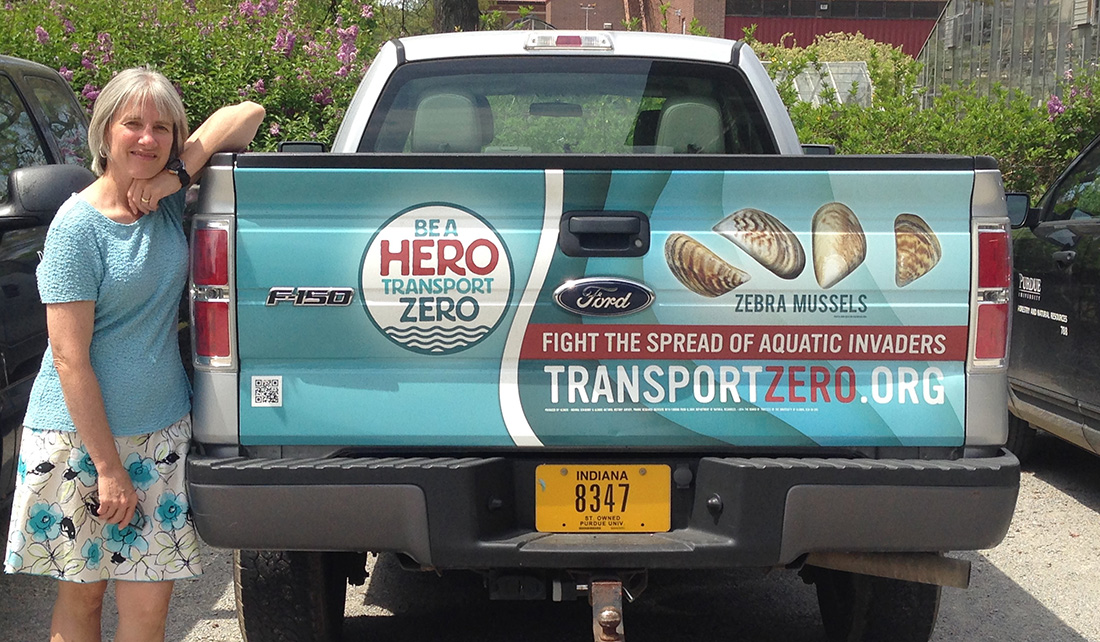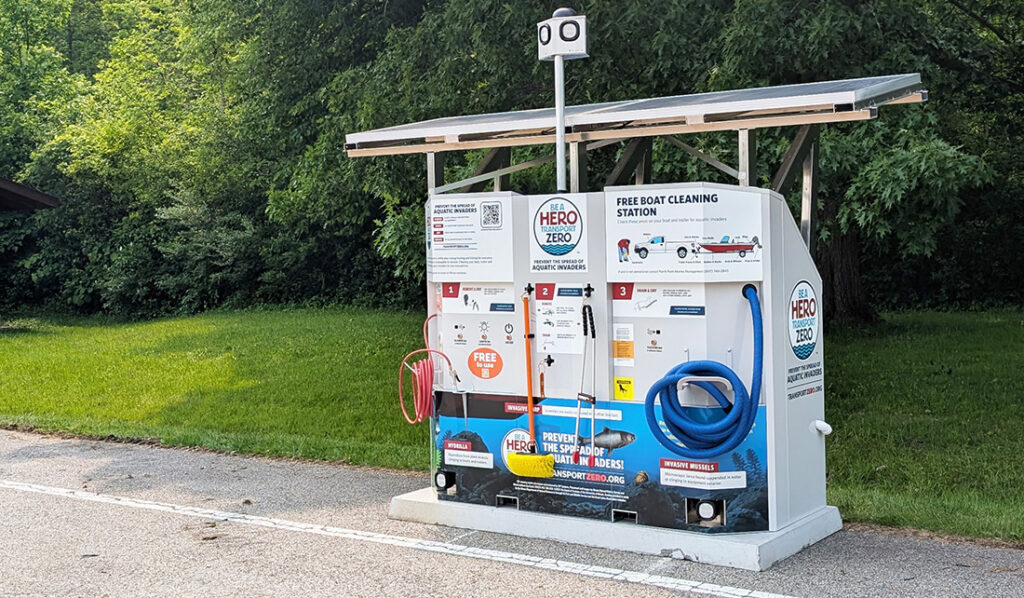
Illinois-Indiana Sea Grant (IISG) is in the midst of its 30th year of dedicated outreach to address the spread of aquatic invasive species (AIS) in Great Lakes waters.
Over time, the basics of doing this work have stayed the same: relying on the latest scientific knowledge, connecting with people on the ground who can make a difference, and training other professionals to help spread the word.
On the other hand, over the past few decades, the AIS outreach team has evolved in how it frames the story of the spread of AIS to better reach audiences with needed information.
In the late 1990s, in terms of outreach, the spotlight was on zebra mussels that had quickly spread throughout the lakes, taking a toll on the food webs. Soon, attention grew to focus on more species such as round gobies, invasive carp and several aquatic plants—as the threats grew. While these efforts met with success, the AIS team decided to shift gears— to be proactive instead of reactive.
“Instead of highlighting the latest invader as they came to light, we directed our efforts to focus on the pathways through which these species are introduced and spread,” said Pat Charlebois, who led IISG’s AIS team for years and is now the program’s assistant director.
This approach allows for more direct targeting of information to specific audiences to take action to prevent the introduction of new species as well as the further spread of an invader via a given pathway. For example, boaters and anglers learn to clean their boats to remove organisms after leaving a waterbody, water gardeners learn to focus on using native plants, and aquarium hobbyists learn to look for alternatives to releasing unwanted organisms into local waters.
Be A Hero
In 2013, in partnership with the Illinois Department of Natural Resources, the AIS team unveiled a new campaign— Be A Hero—that became the state’s official AIS outreach messaging for both aquatic and terrestrial environments. The campaign also included two tracks to address different pathways and reach different audiences.
Be A Hero, Transport Zero, the message for boaters and anglers, kicked off the campaign with a targeted media blitz on several radio and TV shows focused on fishing, as well as a broader approach through social media and online advertising. Since then, the message has been displayed on state and university vehicles, in fishing guides, at boat launches and marinas, and even a banner flown from an airplane over a holiday beach crowd in Chicago. Much of the work of relaying the information has also taken place one-on-one at boat shows, boat launches, and outdoor events.
The result of IISG’s outreach efforts is that boaters in Illinois recognized the Be A Hero, Transport Zero name and messaging at similar levels as they did the longstanding, national campaign Stop Aquatic Hitchhikers, according to a Wisconsin Sea Grant 2022 survey.
Be A Hero, Release Zero was created to reach water gardeners, aquarium hobbyists, teachers, and others who might consider taking unwanted organisms to nearby streams or ponds to set them free. For both Be A Hero campaigns, the AIS team used social science expertise and tools, including needs assessments, surveys, and focus groups, to understand the mindset and motivations of specific audiences and to develop outreach products that incorporate that framing while providing better alternatives to release.
“We are working towards having an open, two-way communication with our audiences,” said Katie O’Reilly, who now leads IISG’s AIS team. “If we are trying to change behaviors, individuals have to actually be engaged and care, rather than just be told what they should do. And it’s important for us to know things that are of concern to them.”

IISG’s Katie O’Reilly and Natalia Szklaruk share AIS information with visitors and the 2025 Rusty Rodeo, an annual event focused on invasive crayfish.
Invasive Crayfish Collaborative
Being proactive can also include filling knowledge gaps to better help resource managers to take action regarding invasive species. And, bringing experts and other stakeholders together to pool information, share ideas, and work together to address the threat.
In 2017, the AIS team led the development of the Invasive Crayfish Collaborative (ICC) to improve management and outreach capabilities to direct attention at this group of invertebrates. Several crayfish species, including the rusty crayfish, are already in the Great Lakes, but many others have not been introduced to these waters.
Today, the ICC has over 150 members that represent government agencies, universities, non-profit organizations, law enforcement, and other entities.
“We are continually adding new people,” said Natalia Szklaruk, IISG’s AIS educator. “We are now recruiting other stakeholders, like teachers, retailers, and outreach practitioners.” This is part of an effort to work through the pathways that crayfish are spread, mainly through the pet trade, via classrooms, and from the culinary world.
As an example, recently the AIS team introduced a new curriculum for Great Lakes educators that provides hands-on activities for students to learn about crayfish and their possible impact on local waters, but the lessons can raise awareness with educators, too.
The collaborative also supported a Purdue University graduate student who focused on educational and culinary settings, assessing the risk of crayfish being released into local waters. In general, with regards to research, the goal of the ICC is to provide a network for scientists to learn from each other about available research and potential knowledge gaps.

New cleaning stations offer an easy, quick way for boaters to wash away any potential hitchhiking AIS.
New Audiences, New Ideas
The team continues to look for new ways to increase the effectiveness of its efforts on the ground. In 2024, IISG organized a hands-on AIS workshop for 150 Illinois conservation police officers who had gathered for their annual meeting. The officers learned about the potential impacts of AIS and how to identify several species of invasive fish, crayfish, and aquatic plants.
“The officers are on the ground enforcing the rules, writing tickets, doing the legwork to stop people from spreading AIS,” said O’Reilly. “They’re our first line of defense in a lot of cases, so by giving them knowledge and resources, we hope if they see something in the field, they know what their next step can be or who to contact to confirm identification.”
This past summer, new cleaning stations opened for business in the Chain O’Lakes State Park and North Point Marina at Winthrop Harbor. As recreationists bring their boats out of these waters, they can easily stop and wash them at these new stations before towing their boats home and on another day, potentially recreating in other water bodies.
Finally, it pays to think outside the box once in a while, and the AIS team is game. A new project combines art and science to present information using a very different approach.
“Through performance art, animation, and other art forms, we are looking to bring new voices into the discussion of preventing the spread of invasive species,” said Greg Hitzroth, IISG’s AIS outreach specialist.

